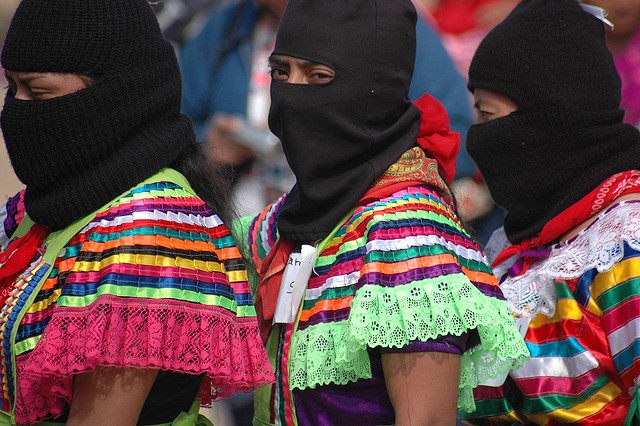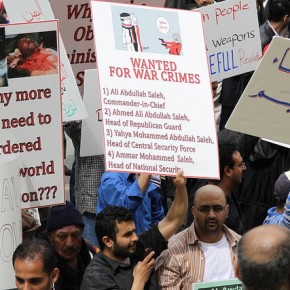War continues in the restive tribal areas of Pakistan and Afghanistan. After several failures at democratization, many of us continue to seek a way to break the impasse. I believe that we must reformulate ourselves, and take inspiration from the Zapatistas.
It is important to say from the outset that the Zapatista model cannot be perfectly exported for use in the “frontier.” The movement is steeped in Mayan traditions, and deliberately seeks to be a local political alternative to Mexican politics. As a result, it doesn’t try to be a model for anyone but the marginalized province of Chiapas in which it arose.
However, that’s the point. The Zapatistas promoted a mixture of socialism, and democratized indigenous values, in order to realize their desire for self-determination. Rather than focus on generalized ideas about global revolt, they prioritized their local communities, and ensured that they work as alternatives to the marketplace as much as possible. In the process, they bypassed elite classes in Mexico that do not value their needs, and hold their indigenous roots in contempt.
Isn’t that the point of socialism? To empower disenfranchised populations, and help secure their freedom? Specifics would be altered for the context of tribal Pakistan, and Afghanistan. However, such culturally specific approaches, mixing the local with largely Western revolutionary political traditions, has to remain the same.
Zapatista achievements are evidence enough for why this is necessary. Although problems of military harassment, and endemic poverty, still plague Chiapas, the Zapatistas have been able to dramatically improve daily life in the areas under their control. Zapatista health-care providers reach 63% of expectant mothers, which is double the comparable rate for non-Zapatista communities in the area. 74% of residents in Zapatista communities have access to toilets, as opposed to 54% among non-Zapatistas. The group has also made major strides in education, and the status of women, in Chiapas.
Most importantly, the Zapatistas have helped restore a sense of dignity to the communities under their care. Although these gains are not material, they nonetheless help realize longstanding political desires, held in check by decades of corruption and racism. Communities that feel understood and respected are far more likely to face down difficult circumstances. Especially in historically under-developed provinces like Chiapas, and Khyber-Pakthunwala, which appear hopelessly lost to outside observers.
To that end, the Zapatistas have helped to facilitate a political renaissance in a fringe area of the Mexican state. This is actually already being done in Pakistan, and Afghanistan, through a bevy of far-right Islamist militia movements. They just doesn’t value the community the same way, and also aren’t particularly democratic, either. Still, since the early 1980s, this has been key to the Islamists’ success. The point, as I see it, is to repeat the mix, albeit with different, and obviously better, politics.

Salafi jihadist ideologies have promoted new forms of social organizing that are somewhat anarchist in their scope. They just rely on hardline interpretations of Islamic doctrine, rather than secular, revolutionary politics. For example, the popularity of groups such as the Movement for Muhammad’s Shariah Law, half-act on local desires for emancipation. Militants usually have a sense that something needs to be expunged in order for them to achieve self-determination. However, for a variety of reasons, they’re deprived of the ability to know what those impediments actually are, which is why an ideological rebirth of the Rashidun Caliphate holds so much value. This is particularly insidious when we discuss their middle class, and Western-born, members.
Radical Islamists push back at oppression in a manner that fails to address problems created by globalization. Similarly, their ideology traps dissent in a box of radicalized tribal Islam, which has been forced onto Salafism by Saudi influence, without any concern for social justice and material inequality. This is a big part of the reason why religious militants are so frequently backed by Pakistani military and intelligence agencies. They profess a typically ideological version of Islam, which sanctifies, rather than threatens, the status quo.
However, if we’re going to articulate such needs for freedom in a truly emancipatory manner, what’s required is a social movement that is able to meet community needs, as many Islamist groups have done over the decades, but as part of a larger program dedicated to pursuing genuine democratic empowerment and social equality. Ideally that type of action would come from the state. Unfortunately, as Afghan and Pakistani politicians continue to succumb to their own worst instincts, it seems obvious that local action is necessary.
I emphasize the point of redressing inequality partially because it was a mainstay of the Afghan Communist era. Authoritarian Khalqis, and Soviet-backed Parchamis, wrongly tried to realizedemocracy by violent means. The idea remains common in cosmopolitan cities in the region such as Lahore. Many Western-minded locals continue to believe that tribal and feudal cultures are the problem, and that they need to be wiped away. The lesson from the Zapatistas is that “tribal” and “modern” are not mutually exclusive, and that new forms of social organizing can mix the two in the same way that Salafi jihadism has done.

Arguably, this has already taken place in the region. Bacha Khan and the Khudai Khitmatgar attempted to realize a grassroots alternative to the various political and economic crises of partition. Although they differ greatly from the Zapatistas on the topic of violence, with the Khudai Khitmatgar emphasizing non-violence, other similarities are immediately obvious.
Both movements bypassed the shortcomings of local political institutions to organize their communities directly, emphasizing collective development and local democratic governance. Unfortunately, Bacha Khan did not leave a bevy of written works, and the Khudai Khitmatgar were mostly crushed by the British Raj and the new Pakistani state. Moreover, it can be difficult to maintain processes of social change over the long-term without institutionalizing it to some extent.
At the same time, the core factors that made the Khudai Khitmatgar popular have not actually changed that much. Back then, the same as now, Khyber-Pakthunwala, and rural areas of Afghanistan, lagged behind neighboring areas in social and economic development because security concerns were always prioritized. Local populations felt like they had to choose between their own cultures, and industrial modernity, in a manner that made them wish they could seek an intermediary. Tribal groups similarly felt helpless in the face of an onslaught that made them increasingly irrelevant, first for the colonial authorities, and now in the context of military, paramilitary, and corporate dominance.
It’s time for a new kind of politics to be practiced, which mixes democratized tribal traditions like the loya jirga, with comparatively “new” ideologies like socialism, to best meet the evolving needs of local populations. The presence of the jirga in the current government of Hamid Karzai is evidence that even global power-players recognize that some mixture is necessary. It’s just that the options that have been tried are unable to sufficiently actualize a yearning for emancipation.
Maybe the problem is one that the Zapatistas, with all their shortcomings, have been able to confront: forgetting that the political is always local, and that freedom, in its broadest and most universal sense, must reflect that.
Photographs courtesy of Shannon, Jayanth Vincent, and the author. Published under a Creative Commons License.





